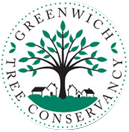By: GREENWICHFREEPRESS | May 17, 2021
Email Print
Last Wednesday, Greenwich Tree Warden Dr. Greg Kramer held a public hearing on the fate of 34 trees posted for removal on the GHS campus as part of the Cardinal Stadium project.
Architect for the BOE Russ Davidson said that the number of trees had been reduced to 21, and it was necessary to cut them down for fire and emergency access, utilities, storm drainage requirements and ADA Access and parking.
Several people spoke in favor of ADA parking, which unfortunately pitted people involved in the stadium upgrade project against people from the Greenwich Tree Conservancy, who don’t oppose ADA parking or accessibility to the stadium.
At the end of the day though, the discord stemmed from the fact trees are posted for removal at the end of a project, rather than the beginning.
On the day of the hearing, Russell Davidson, architect representing the Board of Education, stated for the record that 13 of the 34 trees would not need to be removed for the current phase of the construction project after all.
This brought the number of trees requested for removal down to 21 trees.
Kraemer said the number of trees, species, and Diameter at Breast Height (DBH) measured in inches requested for
removal are as follows:
- (4) Japanese Falsecypress (Cedar) (Chamaecyparis pisifera) DBH of 20, 20, 18 inches and 13 inches.
- (1) Japanese Maple (Acer palmatum) DBH of 23 inches (Not shown in the landscape plan)
- (2) London Plane (Plantanus x acerifolia) DBH of 20 and 18 inches.
- (11) Norway Maples (Acer platanoides) DBH of 29,19,18, 18, 18, 11, 9, 8, 8, 6 and 3 inches.
- (3) White Mulberry (Morus alba), DBH of 27, 20, and 13 inches.
- (1) White Spruce (Picea glauca), DBH of 9 inches.
- (4) Sugar Maples (Acer saccharum), DBH of 42, 13, 13 and 9 inches.
- (3) Japanese Yews (Taxus cuspidate), DBH of 29, 24 and 20 inches.
- (5) White Fir (Abies concolor), DBH of 28, 28, 27, 23 and 17 inches.
On Monday evening Dr. Kramer announced that of the 21 trees remaining posted for removal that an additional 7 would be spared.
“After careful consideration and having listened objectively to the facts and opinions presented by all parties, I have ruled in the following manner on the posted trees listed above and referenced again below: It is my decision and have concluded that the following trees shall remain;
(2) London Plane Trees (Plantanus x acerifolia) consisting of a Diameter at Breast Height (DBH) 20 and 18 inches located along Putman Avenue.
The trees residing in the proposed rain garden (infrastructural improvements) location; (3) Japanese Falsecypress (Cedar), (Chamaecyparis pisifera) DBH 20, 18, and 13 inches, (1) Norway Maple (Acer platanoides) DBH 18 inches, and (1) Japanese Maple, (Acer palmatum) DBH 23 inches.”
The 12 trees Kramer indicates for removal are:
Additional 12 trees have been approved for removal as part of the A.D.A. Access and Parking, the trees approved are as follows:
- (2) Japanese Yews (Taxus cuspidate), DBH of 24 and 20 inches.
- (1) Japanese Falsecypress (Cedar) (Chamaecyparis pisifera) DBH of 20 inches.
- (1) White Mulberry (Morus alba), DBH of 20 inches.
- (2) Sugar Maples (Acer saccharum), DBH of 42 and 13 inches.
- (5) Norway Maples (Acer platanoides) DBH of 29, 18, 18, 18,11 inches
- (1) White Fir (Abies concolor), DBH of 28 inches.
“However,” Kramer said. “The trees approved for removal will only be granted to the Board of Education with the agreement that upon replanting, tree numbers will be doubled the current design requirement of 34 trees; this would equal a total of 68 trees of a size no less than a 2-inch caliper with the species to be determined at the discretion of the Tree Warden. Additionally, the Tree Warden requests an overall comprehensive landscape improvement plan that enhances the areas after construction.”
Kramer shared two notes.
(1) London Plane Tree (Plantanus x acerifolia) DBH 20 inches on Putnam Avenue is on State property and was not posted or part of the tree hearing, however is shown for removal on the plan.
(2) Arborvitae (Thuja occidentalis) DBH 12 and 18 inches along Putnam Avenue are on State property and were not part of the tree hearing, however is shown as removals on the plan.
This is the final decision of the Tree Warden of the Town of Greenwich. Let it be known that Chapter 451, Section 23-59 of the Connecticut General Statutes states “the Tree Warden shall render his/her decision granting or denying the application, and the party aggrieved by such decision may, within ten days, appeal therefrom to the superior court or the judicial district within which such town or borough is located.”
This decision will be posted in the lobby of the offices of the Parks and Recreation Department located on the 2nd floor of the Town Hall, the lobby of Town Hall, the Town Clerk’s office, and the Town of Greenwich website ww.greenwichct.gov/AgendaCenter Parks & Recreation – Public Tree Hearing. It will also be sent to persons present at the Public Hearing and to those who appealed the posting of these trees for removal.
As your Tree Warden, by Connecticut statute, I am charged with the “care and control” of all Town-owned trees. The Tree Division doesn’t take this responsibility lightly. Each and every tree slated for removal is inspected and decided on a case-by-case basis.


